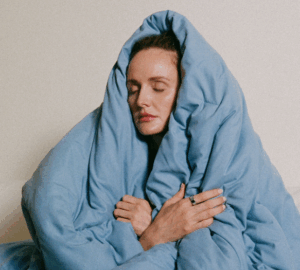- Your sleep needs and preferences change throughout life, which is mediated by hormonal and lifestyle factors.
- As you age, there’s a shift in your sleep architecture specifically – you may get less deep and REM sleep, and experience more fragmented, lighter sleep cycles.
- Hormonal changes that occur during adolescence and again in later life can also impact your sleep habits and diurnal preferences.
You have a unique chronotype, which refers to your body’s natural circadian rhythm. Within your default rhythm, you may experience certain shifts throughout your lifetime.
Sleep During Childhood
| Sleep needed: 9 to 16 hours per 24-hour period depending on age (the younger you are, the more sleep you need!) |
When you’re born, you don’t have an established circadian rhythm yet. You haven’t had a chance for your chronotype to influence your body because those systems in your brain show up later in development. Babies need to prioritize growth over a full night’s sleep, which means children (and as a result, their parents!) have to adapt to a faster feeding cycle.
If you ever feel like babies don’t care about time, you’re right! They eat, sleep, nap, and repeat, regardless of the time of day.
After a couple of months, babies begin to follow a schedule and sleep with a more predictable pattern. At this phase, they may start to express their chronotype.
Young children (2 to 6 years old) usually have a morning chronotype. In early childhood through to adolescence, their diurnal preference starts to lean towards eveningness.
LEARN MORE: What Is Your Chronotype & Why Does It Matter?
Sleep During Teenage Years
| Sleep needed: 8–10 hours per night |
When puberty hits, teenagers tend to notice some physical and emotional changes. A less-talked about change: you may start sleeping when you didn’t before. Now, you might find yourself staying up later and sleeping in, longing for those extra Zzzs instead of getting up for class.
Increasing levels of circulating sex hormones make your internal clock later. This causes a delayed release of melatonin, the sleep hormone. As a result, adolescents tend to stay up later at night and struggle to get up in the morning.
However, due to early school start times, adolescents often experience interrupted sleep. This mismatch between responsibilities and diurnal preference is called “social jetlag,” and it’s a form of sleep deprivation.
Studies have found that adolescent sleep patterns consist of decreasing total sleep time, a delay in the timing of sleep, sleep inertia, and increased daytime sleepiness.
This decrease in sleep quality and social jetlag can impact mood, mental health, cognitive function, academic performance, and overall well-being.
READ MORE: It’s Back-to-School Season: 5 Tips to Help Your Family Sleep Better
Sleep During Adulthood
| Sleep needed: 7 or more hours per night |
With work commitments, family responsibilities, and other lifestyle changes that happen in adulthood, it should come as no surprise that between your 30s to 50s are the years you get the least amount of sleep. Once the rush of hormones from your teenage years begins to let up, most people experience a gradual shift in their circadian rhythm.
You might notice that you can function better on less sleep than you could during your 20s. This isn’t because you need less sleep – rather, it can reflect a routine that is better aligned with your body clock because your chronotype is trending earlier.
However, this isn’t the case for everyone. During adulthood, you may notice distinct patterns in your preferred wake and sleep patterns. Looking at Oura member data, 40% have a preference for evenings, and 60% are morning chronotypes. For evening chronotypes, you still might maintain a similar sleeping pattern as your teen self.
About 1 in 3 adults reported not getting enough sleep. Track your sleep on Oura to make sure you’re getting enough.
Sleep During Senior Years
| Sleep needed: Variable |
As you enter your 50s and beyond, your sleep patterns continue to evolve. The most significant change observed is a shift in sleep architecture, characterized by a decline in deep sleep and REM sleep. You might have more fragmented sleep, waking up more often during the night and struggling to fall back asleep. This reduces your sleep efficiency, a key contributor to your sleep quality.
Hormonal changes, like those experienced during menopause for women, can contribute to this. Hot flashes or night sweats can cause you to wake up often and feel tired come morning time. Having poor quality nighttime sleep contributes to the high prevalence of daytime naps taken by older adults.
Your joints become stiffer and less flexible as you hit your 60s, which can make it uncomfortable to complete your daily tasks and to sleep. This can lead you to spend more time indoors, which has a knock-on effect on your circadian rhythm. Without sufficient sunlight, your circadian rhythm becomes desynchronized, which further reduces sleep quality.
LEARN MORE: 5 Ways to Upgrade Your Sleep Hygiene
Things to Keep in Mind
How and when you sleep can change over time. This can be mediated by changing hormone levels, lifestyle commitments, and your daily routine. Using Oura, you can discover your chronotype and determine whether or not your habits align with your body’s needs. By understanding what forces your circadian rhythm out of alignment, you can adjust your actions to keep your internal clock running smoothly.
Whether it’s a new job, an addition to the family, or retirement, Oura can help ensure that you’re getting enough sleep to enjoy it all.










